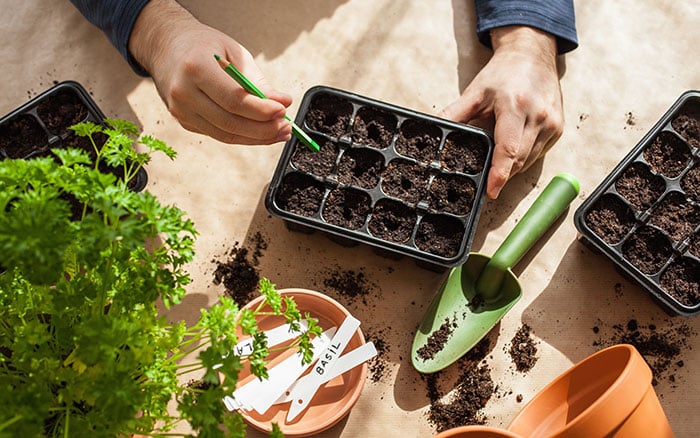March in the garden is ready, set, sow; with seeds ready for planting now. The more you can get in the ground, the more you’ll see bursting into life during the growing season.
Let’s take a look at how you can get a hop, skip and a jump on sowing seeds for spring.
Ways to propagate
Growing from seed is a really inexpensive way to grow and hugely satisfying.
Packet seeds are specially prepared to germinate. They’re disease-free and create super seedlets, so I always recommend buying them rather than gathering your own. Large seeds can be sown by hand; placing seeds on their side at the right spacing distance, and then covering over with soil to the correct depth—each seed packet will give specific instruction.

You can buy a special tool called a dibber which creates the indent in the soil to help you along the way or use a pencil. My top tip is to save your old wine corks and stick these at the right spacing requirements along a 30 cm ruler to create five indents at once.
If you’ve got small seeds, a scatter approach means good coverage but isn’t quite as accurate. Hold the packet and tap the side with your finger as you run it along the soil for more precise dispensing.
When sowing seeds, usually you’re working with planting a large number to increase the chances of success. So it’s also really important to label them at this stage.
Make a move

Small seeds are grown in seed trays, as these are easy to fill and ensure that watering remains consistent. Eventually, these will be “pricked out” or transplanted into larger pots. You can do this simply with a nifty tool called a widger, for mess-free transference.
These young seedlings may not be ready for planting outside, but at this point, their root systems have developed enough to need a larger pot to spread out into, as they require more access to water and nutrients.
My top tip, if you’re reusing old pots, is to wash these out thoroughly. It’s important not to spread diseases to the young plants that may be lurking from previous growth.
Out or in
At this time of year, the biggest risk to young plants out in the garden is frost. So plants can also be started under protection in order to get a jump on growing for spring interest or harvest. You may decide to grow under a cloche or in cold frames to protect them outside. However, it’s not full-proof, so pay extra attention to young and tender growth. Early carrot varieties, like the Baby Chantenay carrots in my Mr Fothergill’s range, are perfect for this.

And beetroot can also be grown under cover to great effect at this time of year too—go to mr-fothergills.co.uk to see my full seed range.
Inside your greenhouse now, you can have tomato, cucumber and even pea seed sown. Come May these can be moved outside to plant out in your veg beds. You may want to move them out for a few hours each day until they acclimatise, this process is called “hardening off”.
Flower power

To ensure early flowering, get Antirrhinums (snapdragons) sown now. These are great plants for kids, being bright and unusual in shape. Just fill your seed tray with compost, you’ll need to get some specifically for young plants so that the structure is loose enough for delicate root systems. Their seeds can be left on the surface of the soil, you don’t need to then cover these over.
When they’re large enough, you’ll transplant them to grow in a cooler climate and, as long as there is no risk of frost, these can be positioned outside in beds about 30cm apart.
Meanwhile, you can get some summer bedding plants on the go in the greenhouse. Sweet peas are such a lovely flowering plant. Annuals can be sown from late January, ready to plant them out in April and flower throughout summer. Perennial sweet peas, which will return to your garden each year, can be planted in spring.
Control and care
With seeds, it’s about recognising that they’re just starting out and, to give them the best chance, they need access to good soil, light and water. Especially when first planted, when fruiting or flowering, plants require extra water.

Take your cue from the weather—each year is different! When you get that first sign of spring in the air, outside growing conditions start to swing in your favour, and you can make the most of growing outside to optimise space in the greenhouse for other things.
Tip:
Peas are sweeter when they’re
first picked as, with time, the sugars
turn to starch.
Now I’ve sown some seeds of thought on starting to grow this March, you can guarantee sowing success this coming spring!
Happy gardening everyone!
Reader questions
How and when should I begin to divide my perennials?

Before the last frost, you can start to divide your summer-flowering perennials as it’s best that the plant isn’t active. Lift plants out gently with a garden fork and shake away the excess soil so that you can divide the root mass cleanly into two. Water in well to ensure healthy growth in the years to come.
Do I need to prune back my dogwood if it has ornamental stems?

Yes, March is a good time to be pruning back, even ornamental woody growth. If Cornus sibirica stems are not cut down from time to time the colour will lessen over the years. Cut back the oldest stems close to ground level and it will encourage new growth to provide a pop of colour next winter.

Leave A Comment